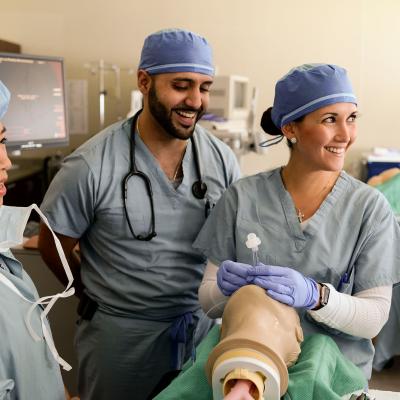- AdventHealth University

Countless lives owe thanks to the technology that has blossomed from the field of radiology. As with all technological development, the radiological field wouldn’t exist without the work, study, dedication, and, in some cases, physical and emotional sacrifices made by its scientific achievers and researchers. Nine of these individuals deserve special distinction.
Raymond Damadian
Born in New York in 1936, Raymond Damadian fathered the modern “Magnetic Resonance Imaging” (MRI) scan through his decades-long research and experimentation with “Nuclear Magnetic Resonance” (NMR). Damadian completed much of his work alone and, throughout his career, struggled to convince others of the merit of his findings. However, when he could not secure funding, he marketed his technology commercially starting in 1980 by building his own company to sell his patented body scanners.
Paul C. Lauterbur and Peter Mansfield
Paul C. Lauterbur and Peter Mansfield together received the Nobel Prize in Physiology or Medicine awarded in 2003. These two scientists also contributed greatly to the development of MRI technology. Lauterbur first experienced NMR technology while in the U.S. Army before being discharged in 1955 and continued his research in academic settings. He conceptualized MRI machines and believed they would be capable of 3-D imaging long before most of his contemporaries were convinced that the science would ever become more than a niche novelty.
Mansfield, born in London in 1933, worked as a tradesman during the day and studied at night when in high school in order to gain entrance to Queen Mary College to study physics. Just a few short years after graduation, Mansfield worked with a team to develop the mathematical sequencing needed to interpret MRI signals and convert them to images. Mansfield was the first person to ever step into a full-body scanner in 1978. At the age of 85, Mansfield passed away on February 8, 2017.
Godfrey Hounsfield
Godfrey Newbold Hounsfield, another Nobel Prize winner that received his award in 1979, worked within the realm of X-ray technology and made vital contributions to the development of computed tomography (CT). He invented the Computed Axial Tomography (CAT) scanner, a device and method of using computer software to produce cross-sectional images from multiple x-ray projections and to render three-dimensional images from x-ray scans taken at multiple angles. He tested his prototype on himself, the first live human to receive the scan, in 1971. Production of a commercial scanner soon followed. CAT scans have allowed for huge advancements in the health industry and have affected countless lives.
Edward Purcell and Felix Bloch
In 1945, two men met at a gathering of the American Physical Society. Edward Purcell, a Harvard Graduate, and Felix Bloch, a product of Stanford, discussed their current projects and realized they both were attempting to apply nuclear magnetic resonance (NMR) technology to solve biology and physics quandaries. Both men went on to make significant discoveries in various biological and non-biological fields, and their work contributed to the foundation of MRI development. Purcell and Bloch jointly received the 1952 Nobel Prize in physics.
I. I. Rabi
Isidor Isaac Rabi was born in Austria and graduated from Cornell University in 1919. After spending time in Europe studying under the tutelage of celebrated names in the field of quantum mechanics, he returned to the United States in 1929 and taught physics at Columbia University while conducting research on nuclear spin and its resulting “magnetic moment.” He developed the methods that would eventually lead to magnetic resonance imaging (MRI). Rabi was awarded a Nobel Prize in Physics in 1944.
Alice Ettinger
Alice Ettinger was born in 1899 in Berlin, Germany and received a medicinal degree there in 1924 before pursuing further medical education and training. She held her first research position under Dr. Hans Heinrich Berg, a revolutionary gastrointestinal x-ray technologist and the inventor of a spot-film device that allowed physicians to capture snapshots of imaging sequences for further inspection. When an American professor by the name of Dr. Joseph Pratt requested that Dr. Berg send a qualified assistant to demonstrate his device at Tufts Medical School in Boston, Ettinger was chosen and what she expected to be a six-week trip to the U.S. turned into a 50-year research and teaching career at Tufts Medical School and beyond. Ettinger was world-renowned for her passion, energy, and limitless thirst for both learning and teaching, finally retiring from her career at the age of 86 in 1985.
Edith Quimby
Born in Illinois in 1891, Edith Hinkley Quimby relocated to New York with her husband Shirley Leon Quimby immediately following the First World War. While Shirley pursued a doctoral degree, Edith took a research assistant position — rare for a woman in 1919 — developing safer use of x-rays and radium in medical imaging applications. Edith became an invaluable asset to the field and her status blossomed into full-fledged professor and decorated researcher over her 35-year career.
Learn More
The AdventHealth University Online Bachelor of Science in Imaging Sciences offers working imaging professionals an expanded opportunity to learn the technical, medical and people skills to help them continue their professional growth. Whether your goal is to provide a higher level of patient care or to advance your career by moving into management, education, consulting, or industry, the place to begin is with a Bachelor of Science in Radiologic Sciences degree.
Sources
https://www.pbs.org/wgbh/theymadeamerica/whomade/damadian_hihtml
https://phys.org/news/2017-02-peter-mansfield-nobel-winner-mri.html
http://www.histmodbiomed.org/article/professor-sir-peter-mansfield
http://www.nasonline.org/publications/biographical-memoirs/memoir-pdfs/lauterbur-paul.pdf
https://www.nobelprize.org/nobel_prizes/medicine/laureates/1979/hounsfield-facts.html
https://www.ncbi.nlm.nih.gov/pmc/articles/PMC5144463/
http://www.osti.gov/accomplishments/purcell.html
https://www.osti.gov/accomplishments/bloch.html
https://www.aps.org/publications/apsnews/200607/history.cfm
https://www.osti.gov/accomplishments/rabi.html
http://jnm.snmjournals.org/content/6/5/383.full.pdf
http://www.atomicheritage.org/profile/edith-quimby
https://cfmedicine.nlm.nih.gov/physicians/biography_105.html


